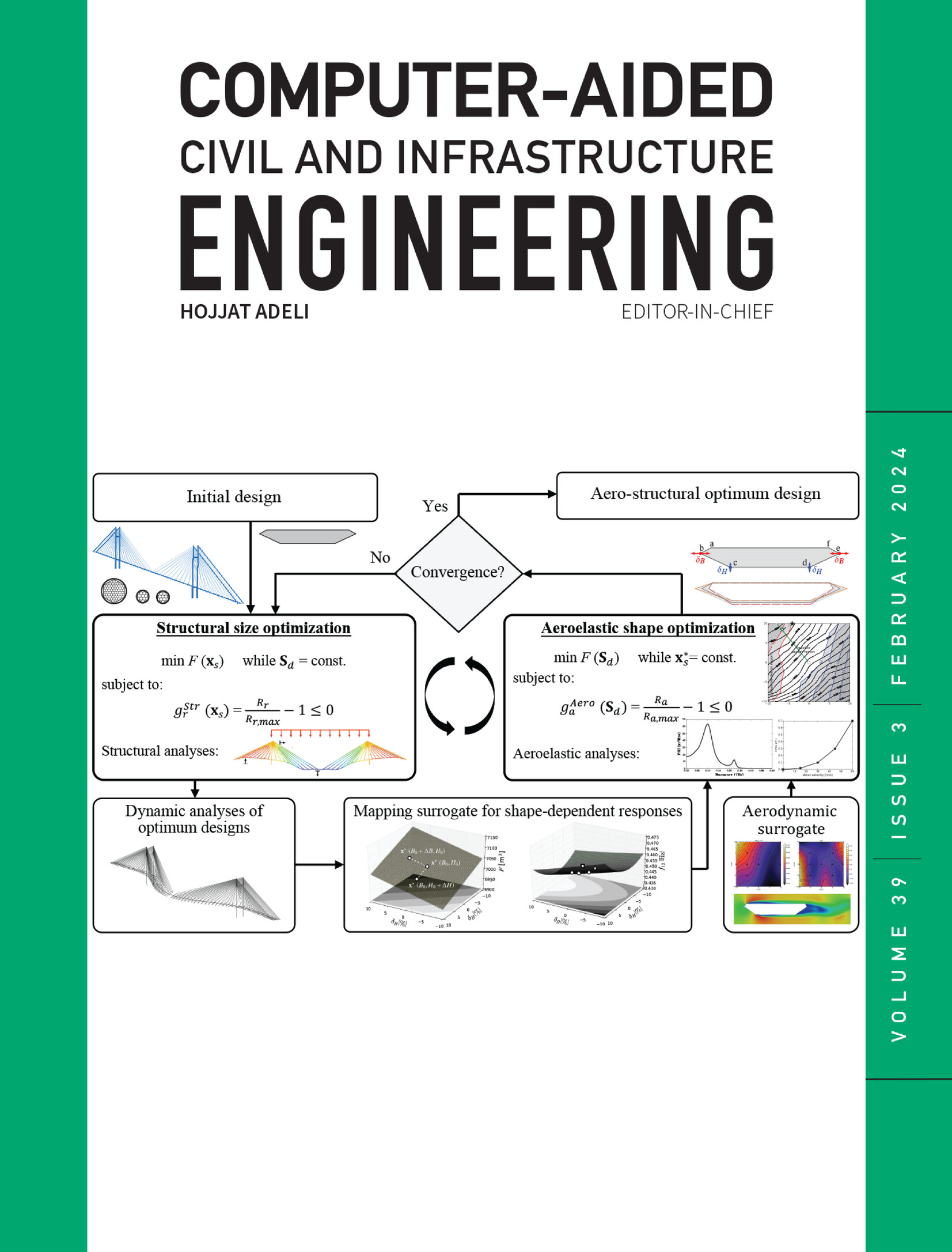基于物理约束神经网络的轮辐索网结构自动找形方法
IF 8.5
1区 工程技术
Q1 COMPUTER SCIENCE, INTERDISCIPLINARY APPLICATIONS
引用次数: 0
摘要
轮辐索网结构是一种典型的柔性拉伸结构,完全依赖于电缆作为承重部件。其独特的拓扑特征,由环形电缆和径向电缆组成,决定了其寻找形式的主要挑战在于控制内环的空间配置。现有的计算方法主要依赖于基于经验试错的数值迭代,难以有效解决预应力分布与环索几何形态之间的多变量耦合问题。因此,本文旨在建立一个基于深度学习的几何约束和物理方程驱动的自主寻形框架,以实现预应力分布和空间配置的同时智能求解。通过各种规则和不规则几何形式的案例研究,验证了该方法的有效性和通用性。为了提高复杂几何结构的寻形精度,实现了一种结合自适应矩估计和有限记忆Broyden Fletcher Goldfarb Shanno算法的双优化策略。对于跨越100米的辐条索网结构,智能寻形精度可以保持在1厘米以内,确保令人满意的寻形结果。提出的深度神经网络(DNN)方法将索的受力分布与几何构型自动关联起来,为柔性索结构的自动形状确定和构型设计提供了一种新的计算方法和求解途径。本文章由计算机程序翻译,如有差异,请以英文原文为准。
Automated form‐finding method of spoke cable net structures using physics‐constrained neural network
The spoke cable‐net structure is a typical flexible tensile structure that relies solely on cables as load‐bearing components. Its unique topological characteristics, composed of ring cables and radial cables, determine that the main challenge in its form‐finding lies in controlling the spatial configuration of the inner ring. Existing computational methods primarily rely on numerical iteration based on empirical trial and error, which makes it difficult to effectively address the multi‐variable coupling problem between the prestress distribution and the geometric configuration of the ring cables. Accordingly, this paper aims to establish a deep learning‐based autonomous form‐finding framework driven by geometric constraints and physical equations to achieve the simultaneous intelligent solution of prestress distribution and spatial configuration. The effectiveness and versatility of the proposed method are validated through case studies with various regular and irregular geometric forms. To enhance the precision of form‐finding for structures with intricate geometries, a dual‐optimizer strategy integrating the adaptive moment estimation and limited‐memory Broyden Fletcher Goldfarb Shanno algorithms is implemented. For a spoke cable‐net structure spanning 100 m, the intelligent form‐finding accuracy can be maintained within 1 cm, ensuring a satisfactory form‐finding outcome. The proposed deep neural network (DNN) method automatically correlates cable force distribution with geometric configuration, offering a novel computational approach and solution pathway for the automated shape determination and configuration design of flexible cable structures.
求助全文
通过发布文献求助,成功后即可免费获取论文全文。
去求助
来源期刊
CiteScore
17.60
自引率
19.80%
发文量
146
审稿时长
1 months
期刊介绍:
Computer-Aided Civil and Infrastructure Engineering stands as a scholarly, peer-reviewed archival journal, serving as a vital link between advancements in computer technology and civil and infrastructure engineering. The journal serves as a distinctive platform for the publication of original articles, spotlighting novel computational techniques and inventive applications of computers. Specifically, it concentrates on recent progress in computer and information technologies, fostering the development and application of emerging computing paradigms.
Encompassing a broad scope, the journal addresses bridge, construction, environmental, highway, geotechnical, structural, transportation, and water resources engineering. It extends its reach to the management of infrastructure systems, covering domains such as highways, bridges, pavements, airports, and utilities. The journal delves into areas like artificial intelligence, cognitive modeling, concurrent engineering, database management, distributed computing, evolutionary computing, fuzzy logic, genetic algorithms, geometric modeling, internet-based technologies, knowledge discovery and engineering, machine learning, mobile computing, multimedia technologies, networking, neural network computing, optimization and search, parallel processing, robotics, smart structures, software engineering, virtual reality, and visualization techniques.

 求助内容:
求助内容: 应助结果提醒方式:
应助结果提醒方式:


